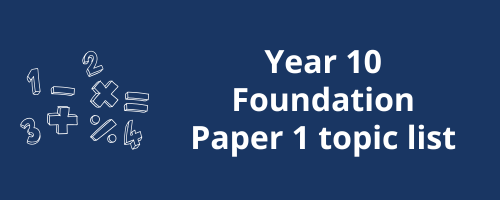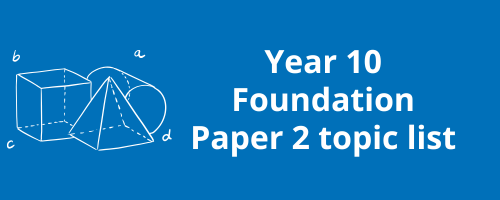KS4 Maths – Foundation
Please click on the links below to find out more about each unit.
| Year Long Term Objective: To Build upon the foundation laid in KS3 to prepare students for the rigours of the GCSE. Students should be stretched with challenging GCSE style questions routinely. | ||||||
| Year | Autumn 1 | Autumn 2 | Spring 1 | Spring 2 | Summer 1 | Summer 2 |
| Medium Term Objective: Autumn: Recap and extend students on fundamental number and algebra work. Spring: Work on geometry, while stretching students by interleaving with number and algebra exam problems. Summer: Enhance students proportional reasoning skills and develop ability at harder exam questions. | ||||||
| 10 |
|
|
|
|
|
|
| 11 |
Algebra | Equations, Inequalities and sequences | Averages and Range | Transformations | Right Angled Triangles | |
Revision topic lists for Year 10
The video below is a guide to using the Sparx Codes listed on the topic lists above to help with your revision. (The transcript is available below)
0:01 Hi, I'm Mr. Smyth. In this video, I'm going to show you how you can use Sparks Maths in order to revise for the upcoming mock.
0:11 So, this is your Sparks page. From here, you just need to press on Independent Learning. Uhm, so, normal homework's there, but this is Independent Learning.
0:20 We're turning off the homework for two weeks, so it's giving you a chance to do this. And then you have lots of topics you can do.
0:27 First thing, though, is Curriculum. You're doing the GCSE. So, change that to GCSE. And the second thing is to know what level you need to do.
0:37 If you're in Sets 1 to 3, you are doing Higher. So, you need to be on Level 3, 4 or 5.
0:45 And if you're in Sets 4 or 5, you are doing Foundation. So, you need to have this on Level 1 or Level 2 or Level 3.
0:53 So, Level 1, 2 and 3, Foundation. Level 3, 4 and 5 for Higher. I'm going to put it on level 3 for this demonstration.
1:00 Now, we're looking at codes. So, if we go to this kind of page, you've been given this list of topics.
1:09 You've got a Date Revised and a Date Revisited. Let's choose a topic, um, using Probability Phrases, which is U803. So, we go back to our page, type in U803, and we get Using Probability Phrases.
1:26 When you click on that, you get three different levels of question. Introduce gives you a sort of basic idea of the question.
1:32 So, a bag of marbles, all the marbles in the bag are green. Describe the probability that a marble chosen at random from this bag will be green.
1:39 Brilliant. You could watch the video. I think we've got a good idea that the answer is certain. Wonderful. You've got it right.
1:46 Um, if you think those questions are a bit easy for you, you can always go on to the Strengthened Questions, sort of a level higher.
1:54 So, choose a word from this list to complete the following sentence. When a normal fair coin is flipped it is something that it will show tails.
2:03 So, we're going to say evens in this question. And, if we go to a harder question. I have three triangles and one circle. I want to add circles so that it is more likely I will randomly choose a circle than a triangle.
2:19 What's the smallest number of circles I could add? Potentially, you might need a video. And it gives you a question very, very similar.
2:27 To make it more likely that I will choose a blue ball than a red one. I need to have more blue balls than I have red ones.
2:36 So, since there are six red balls, I need at least one more blue ball from that, which is seven. And since we're looking for the smallest number to add, I would only need seven blue balls and no more.
2:48 So, how many do I need to add to get for my existing two to the seven I need? Well, that's simply seven.
2:55 So, track two, which is five. So, I need to add five blue. Brilliant. Got the idea. So, I need four circles.
3:05 It's currently one. Four take away one. It's three. We've got it. And that's your key to being successful through your marks.
3:14 Um, keep working through. Let's get to the harder questions. And the further you're able to go, the more successful you will be.
3:22 All the best of your revision. Thank you.


